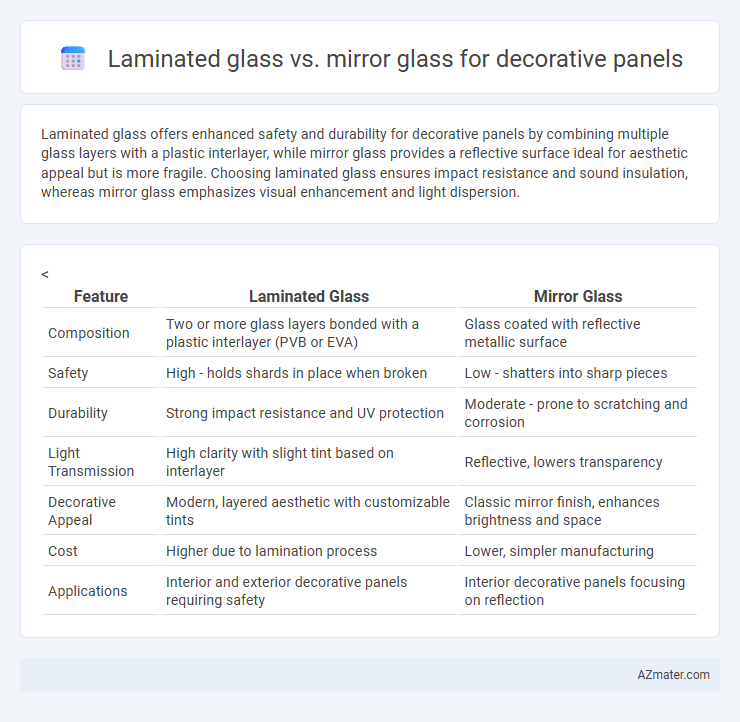Laminated glass offers enhanced safety and durability for decorative panels by combining multiple glass layers with a plastic interlayer, while mirror glass provides a reflective surface ideal for aesthetic appeal but is more fragile. Choosing laminated glass ensures impact resistance and sound insulation, whereas mirror glass emphasizes visual enhancement and light dispersion.
Table of Comparison
| Feature | Laminated Glass | Mirror Glass |
|---|---|---|
| Composition | Two or more glass layers bonded with a plastic interlayer (PVB or EVA) | Glass coated with reflective metallic surface |
| Safety | High - holds shards in place when broken | Low - shatters into sharp pieces |
| Durability | Strong impact resistance and UV protection | Moderate - prone to scratching and corrosion |
| Light Transmission | High clarity with slight tint based on interlayer | Reflective, lowers transparency |
| Decorative Appeal | Modern, layered aesthetic with customizable tints | Classic mirror finish, enhances brightness and space |
| Cost | Higher due to lamination process | Lower, simpler manufacturing |
| Applications | Interior and exterior decorative panels requiring safety | Interior decorative panels focusing on reflection |
Introduction to Decorative Glass Panels
Decorative glass panels enhance interior design through materials like laminated glass and mirror glass, each offering unique benefits. Laminated glass provides safety and sound insulation by bonding two or more glass layers with an interlayer, making it ideal for modern, durable decorative applications. Mirror glass, known for its reflective surface, amplifies light and space, creating visually striking panels that add depth and sophistication to any environment.
Understanding Laminated Glass
Laminated glass consists of two or more glass layers bonded with an interlayer, offering enhanced safety, sound insulation, and UV protection compared to mirror glass, which primarily serves reflective purposes. This interlayer prevents shattering, making laminated glass ideal for decorative panels in high-traffic or safety-conscious environments. Its customizable thickness and finishes provide versatile design options, combining durability with aesthetic appeal.
Overview of Mirror Glass
Mirror glass for decorative panels offers a highly reflective surface that enhances room brightness and creates an illusion of spaciousness, making it ideal for modern interior design. It typically consists of a glass substrate coated with a reflective metal layer, such as silver or aluminum, providing clear and sharp reflections. Compared to laminated glass, mirror glass emphasizes aesthetic appeal and visual impact rather than structural safety or sound insulation.
Visual Appeal: Laminated vs Mirror Glass
Laminated glass offers enhanced visual appeal for decorative panels through its ability to incorporate custom designs, colors, and textures within the layers, creating a multidimensional and durable aesthetic effect. Mirror glass provides a sleek, reflective surface that amplifies ambient light and space but lacks the design versatility and safety benefits inherent to laminated glass. Choosing laminated glass enhances creative expression and safety, while mirror glass maximizes brightness and spatial perception in interior design.
Safety and Durability Comparison
Laminated glass for decorative panels offers enhanced safety due to its multi-layer structure, which holds shards in place upon impact, reducing injury risk compared to mirror glass that can shatter into sharp fragments. Durability of laminated glass surpasses mirror glass as it resists cracking and damage from heat and moisture, making it suitable for high-traffic or humid environments. Mirror glass, while visually appealing, is more prone to scratches and breakage, compromising both aesthetics and safety in long-term use.
Acoustic and Thermal Insulation Properties
Laminated glass offers superior acoustic insulation for decorative panels by incorporating a PVB interlayer that effectively reduces sound transmission, making it ideal for noise-sensitive environments. It also provides enhanced thermal insulation, helping to maintain indoor temperature and improve energy efficiency. Mirror glass, while reflective and aesthetically appealing, lacks significant acoustic and thermal insulation properties compared to laminated glass, limiting its effectiveness in sound and heat management.
Maintenance and Cleaning Considerations
Laminated glass decorative panels require minimal maintenance due to their durable interlayer that resists cracking and easy-to-clean surfaces that prevent dirt buildup. Mirror glass panels demand frequent cleaning to maintain reflective clarity, as they are more prone to smudges, fingerprints, and streaks. Both materials benefit from gentle, non-abrasive cleaning agents and microfiber cloths to avoid surface damage during maintenance.
Design Flexibility and Customization
Laminated glass offers superior design flexibility for decorative panels through its ability to incorporate various interlayers, colors, patterns, and printed graphics, enabling customized aesthetic and functional effects such as UV protection and sound insulation. Mirror glass, while providing a sleek reflective surface ideal for space enhancement and visual expansion, limits customization to tinting and surface treatments without altering its fundamental reflective properties. Choosing laminated glass allows for more intricate and personalized design solutions, whereas mirror glass serves best when uniform reflectivity and minimalist design are priorities.
Cost Factors: Laminated Glass vs Mirror Glass
Laminated glass for decorative panels generally incurs higher costs due to its multi-layer construction and enhanced safety features, which increase material and manufacturing expenses. Mirror glass tends to be more affordable, driven by simpler production processes and lower raw material costs. Budget considerations often favor mirror glass for large-scale projects, but laminated glass offers long-term value through durability and impact resistance.
Best Applications for Each Glass Type
Laminated glass is ideal for decorative panels requiring enhanced safety, impact resistance, and sound insulation, making it perfect for high-traffic areas and spaces demanding security, such as commercial interiors and public buildings. Mirror glass suits applications emphasizing aesthetic appeal and light reflection, commonly used in residential decor, feature walls, and retail displays where visual expansion and elegance are priorities. Selecting between laminated and mirror glass depends on balancing safety features with design goals to achieve optimal functionality and style.

Infographic: Laminated glass vs Mirror glass for Decorative panel
 azmater.com
azmater.com